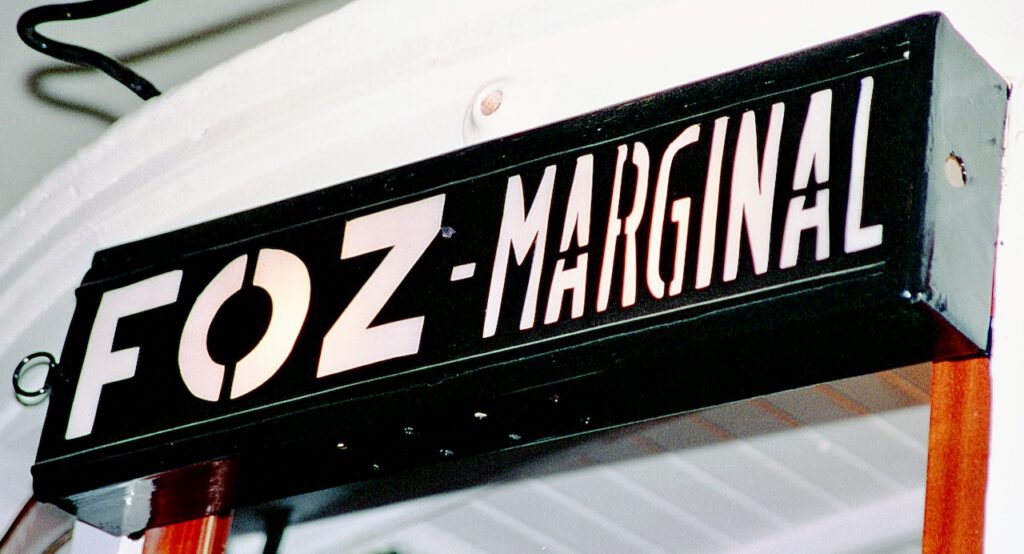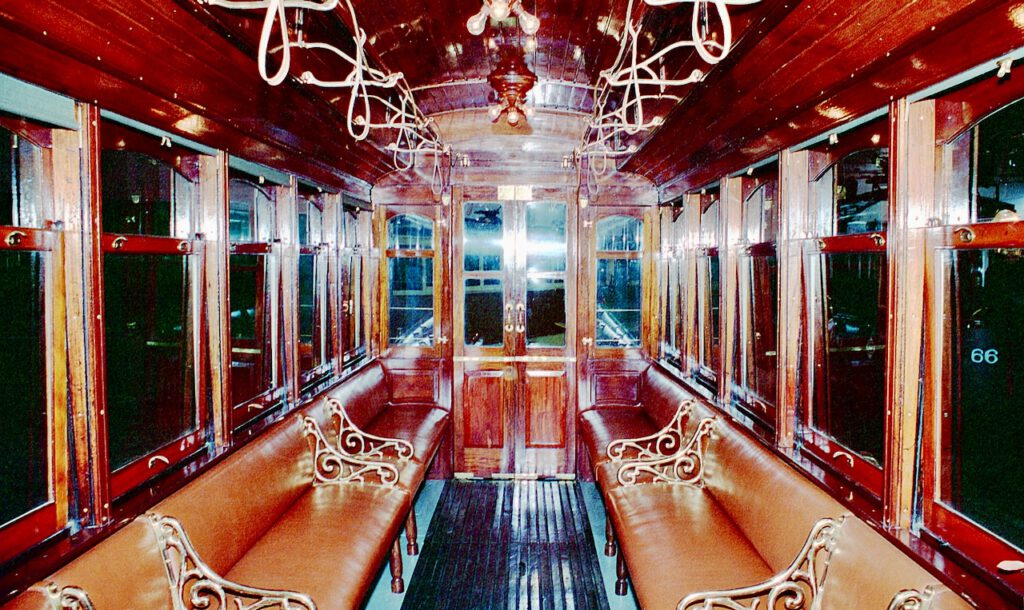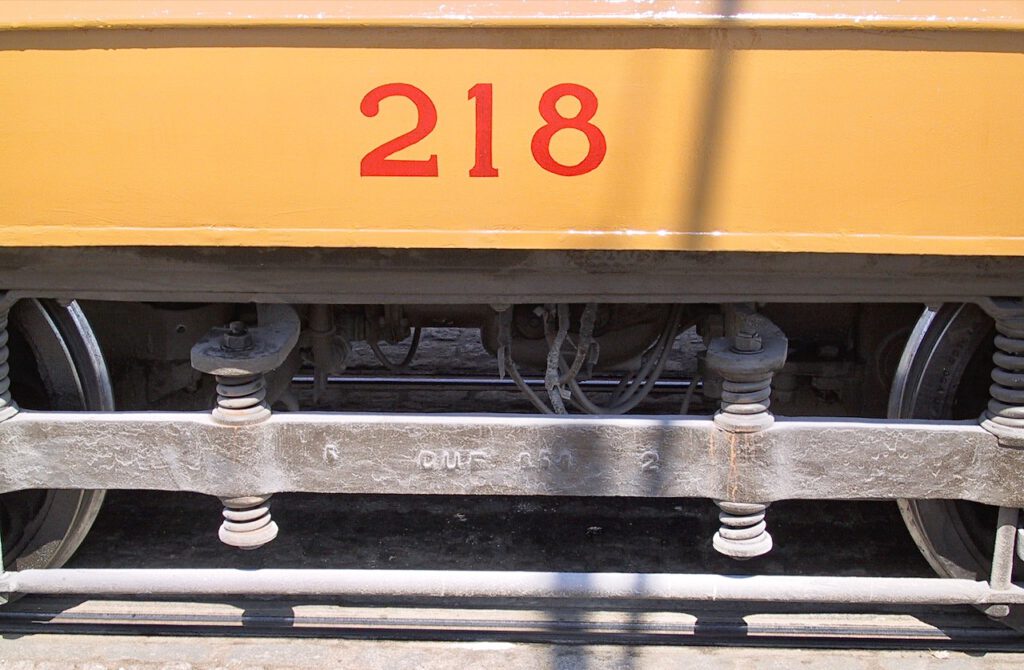The history of the many types of Porto tram cars is complex. On other pages the individual types will be discussed. On this page is an overview about their common history.
The livery of the trams during the earliest years is not known, but photos prove there were several different schemes. Since 1904 the trams were painted light green and white1, in 1933 this was changed to yellow and white2. The STCP changed the colours to ochre with cream after take-over in 1946.
Since the 1920’s open platforms got windscreens when trams got a major overhaul. Providence fenders were mounted on the tramcars in 1925/6. Since about 1946 these were gradually replaced by gate-and-tray lifeguards.

Replacement of the destination blinds by stencil boxes, which could be illuminated, started in 1926. Line numbers were in 1912 introduced and first indicated with a round plate that likely not only displayed the number, but also the line colour. From about 1930 these plates changed to white with black numbers and of square shape with rounded corners. Replacement of the line number indications from metal plates to stencil boxes was started around 1946.
The oldest tramcars had longitudinal benches like also the closed mule trams had. The trams acquired between 1907 and 1914 had transverse seats in 2+1 configuration. Trams acquired or built after 1924 had transverse seats in 2+2 configuration. This could be done because these trams were about 20 cm wider than the older trams and the aisle was about 20 cm narrower. In the late 1950’s the seat arrangement was changed from 2+2 to 2+1, reducing the number of seats and increasing the standing capacity. Change of seat cover from rattan to artificial leather started in 1950.
Names and nicknames
An electric trams is called in Portugal “Carro Eléctrico”3, in the literature shortened to “CE”. Over the years many names were used to indicate the type of a tramcar. The use of some names disappeared, while others were only used in later times. But also the same type of car could be indicated with several different names at the same time.
During the first years of the electric trams those which were made out of mule cars were called “Transformados“. The remaining mule cars were at that time called “Carros ordinários”, “Carros simples” or “Carros antigos”. In later years they became “artrelados” or “atrelados antigos” to distinguish them from the newly built trailers. “Carros antigos” became now the indication for all pre-1904 electric trams, but later they were called “Carris-18”, “Carros pequenos” or “Carros abertos”. The latter was used when they were the last ones with open platforms. Of course before “Carros abertos” were open cars, but those had disappeared by that time.
The 6-window cars built by Constructora were always called “Constructora”, however in the 1930’s they also belonged with the older trams to the group “Carros de bancos”, a group that was by the STCP called “Risca-ao-meio” (Divided in halves) because of their two longitudinal benches.

The four 7-window cars made by Constructora in 1907/9 were ambiguous, sometimes “Constructora”, but later often (erroneous) “Brill-23”.
The “Carros Ingleses” were for a long time also called “UEC” and in their early years “Mountain Gibson” cars.
Until the mid 1920’s the cars built by Brill were just “Brill”, but they became “Brill-23” when it became necessary to distinguish them from the larger, wider types made by the workshops. The number indicated the number of seats. However when in the 1950’s the number of seats was reduced in the wide cars by changing the 2+2 configuration to 2+1, the indications for those trams were retained: Brill-28 and Brill-28 Plataforma Salão.
The 8-window Brill type made by the workshops was “Brill-32” but became “Italianos” when the STCP installed Italian made motors.
“Brill-40” was sometimes used for Brill-bogie trams, but also “CFP-40 (plataforma) fechada”.
“Familleureux” was used together with “Belgas”.
“CFP-40 (plataforma) aberta” and “CFP-28” or “Carris-28” were used for the trams also called “Fumista bogie” and “Fumista”, but the very first car called “Fumista” was the open cross-bench mule tram of the CCA that arrived in October 1871.
The new STCP built tramcars were called Pipis, or Pipizinhos for the small version.

Numbers, numbers, numbers
Every tramcar has its own number as identification. This for the sake of allocating them to services, tracking (the need of) maintenance, insurance etc. Most tram companies sometimes renumber a part of their fleet, but renumbering the whole fleet is not common. Renumbering the whole fleet several times is rare, but Porto did it. Alas many data how it was done are lost. This makes a reconstruction of the history difficult.
The CCFP had numbered the passenger mule trams / trailers and the freight trams both starting with 1. When the fleet of the CCA was merged with the one of the CCFP this principle was retained, but it’s unknown how the cars were renumbered to make new series 1-93 for the passenger trams and 1-24 for the freight trams.
When the first electric trams were introduced, they got their own series starting with 1. A few years later this was repeated with the introduction of the first two electric freight trams. In 1901 there were electric trams (carros eléctricos) with the numbers 1-30, electric freight trams (rebocadors eléctricas) 1-2, mule trams / trailers (carros antigos) with the numbers 1-93 (with gaps) and freight trailers (zorras atreladas) with the numbers 1-41. Likely this was confusing, for renumbering was done giving all vehicles an unique number.
The electric freight trams got the numbers 81-82 and four new ones the numbers 83-86. The trailers were numbered above 100 with the freight trailers getting the highest numbers. The exact ranges are unknown, but photos show freight trailers with numbers in the 190 and 200 series. When in 1904 the unique bogie car was acquired from Brill, it got the number 90. There is photo evidence that about 1901-1903: several cars were renumbered. In 1905 the fleet of electric freight trams was renumbered again, now starting from 220.
In 1907 (February-June) the complete fleet of electric trams was renumbered by adding 100. At the same time also the trailers were renumbered getting numbers below 100. Until the outbreak of WWI the fleet grew significant in size, but, at least to CCFP standards, little renumbering was done in the period until 1924:
- 1-7 Bogie trailers
- 8-59 Old trailers
- 60-98 (with gaps) Freight trailers
- 101-116, 118-132, 136-139, 167, 170 Pre-1904 trams
- 141-142 Open trams
- 143-145, 147-154, 157-166, 168-169 Constructora 6-window
- 171-190 Brill (1912 order)
- 191 Brill-bogie (until 1913 it had the number 190)
- 199-201, 250 Constructora 7-window
- 220-248 Electric freight trams
- 251-270 Brill (1909 order)
- 271-295 Brill (1910 order)
- 296-300 UEC (until 1913 these cars had the numbers 202-206)
In 1924/25 most of the electric fleet was renumbered. There is no information about the way this was done. The reasons were likely that about this time many cars got new motors and the (new) car number indicated the type of electric equipment rather than the type of car. Although it’s unknown for many numbers, which type of car it was, it’s known which numbers were occupied before new built trams started to arrive in 1926:
- 100-136 Likely of these the trams with the highest numbers had Siemens D58 motors.
- 151-186 Number 150 appeared in 1928.
- 201-249 Likely all these trams had GE270 motors. The first new built bogie tram had no.200.
- 301-328 Electric freight trams.
Between 1924 and 1946 many cars got a new number again, probably because of new electric equipment. Also new cars were built. As a result gaps were falling into both the 100 and 150 series, but the 200 series continuously grew without ever falling a gap and by 1929 reached 300. Now the electric freight trams were renumbered to 50-78 and the remaining trailers into a group 1-20, apparently by giving the cars with the highest numbers the lowest available, and the freight trailers from 79 up.
In 1935 the electric tram fleet reached the number 320 and from this year the numbers from 199 down were filled, which resulted that in 1946 the following numbers were in use:
- 102-110 Five pre-1904 cars and four 6-window Constructora. All nine had Siemens D53 motors.
- 120-132 (with gaps, total seven cars) Five Brill-23 and two 6-window Constructora. All seven had Siemens D58 motors.
- 155-158, 160-161 All six were pre-1904 cars. Motor type is unknown.
- 165-320 (without gaps) No pre-1904 cars, one 6-window Constructora, all other types. Most had General Electric GE270 motors, the others modified GE80 or D53 motors.
The STCP renumbered the fleet again in 1946/7.
- 101-104 pre-1904 tramcars, the other seven still existing of these types were earmarked to become trailers series 21-27, but it appears this was done only partially with the others complete disposed off.
- 105-111 6-window Constructora
- 112-114 7-window Constructora
- 115-119 UEC (Carros Ingleses)
- 120-146 Brill-23
- 150-168, 170-199 Brill-28
- 169, 200-223 Brill-28 Plataforma Salão
- 249 Brill-bogie of 1904
- 250-261 Brill-32
- 266-269 Fumista-bogie
- 270-277 Brill-Bogie
- 280-289 Belga
- 300-315 Fumista
STCP also built 31 new trams:
The existing trailers and freight/works trams were not renumbered, but because the number of trailers went up, also their range. That resulted in:
- 1-7 Bogie trailers
- 8-13 Old two-axle trailers
- 18-20 Fumista trailers
- 21-24 Trailers converted out of the oldest motorcars
- 28 Pipizinho. This trailer was converted into motorcar no.405
- 48 Grinder motorcar
- 49 Overhead wire repair motorcar
- 50-72, 75, 77-78 Zorras
- 73-74, 76 Vagões
- 79-98 (with gaps) open freight trailers
- CCFP mentioned this colour scheme of light green and white in a letter to Brill about the 1904 acquired bogie tramcar. ↩︎
- When looking to old photos, it must be realized that often orthochromatic emulsions were used that turn yellow (and red) very dark. ↩︎
- Nowadays a “carro elétrico” (modern / Brazilian spelling) is also used for battery powered electric cars. Modern lightrail vehicles are called “Metro”, never carro elé(c)trico. ↩︎


Leave a Reply